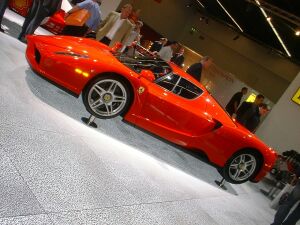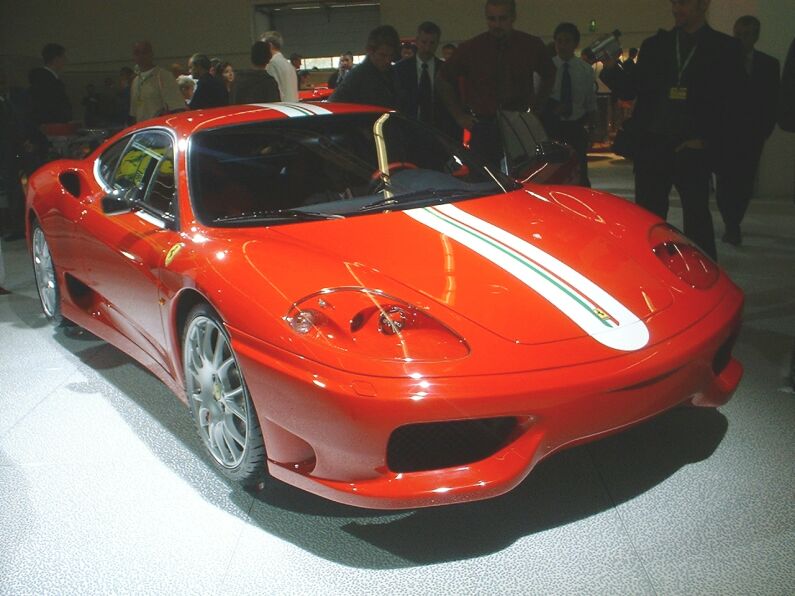12.09.2003 FERRARI UPBEAT IN FRANKFURT AS WRAPS COME OFF THE 575GTC
 The
60th Frankfurt Motor Show comes at a particularly important moment for
Ferrari both in terms of its sporting and commercial activities. The company
is also enjoying a very solid economic position in what is proving to be
a difficult period for the rest of the sector. In fact, its optimism regarding
the future is embodied in the new 2+2 due to be unveiled in early 2004.
The
60th Frankfurt Motor Show comes at a particularly important moment for
Ferrari both in terms of its sporting and commercial activities. The company
is also enjoying a very solid economic position in what is proving to be
a difficult period for the rest of the sector. In fact, its optimism regarding
the future is embodied in the new 2+2 due to be unveiled in early 2004.
The plus side of the harsh competition Ferrari faces from the other major car constructors with the advent of each new Formula 1 Grand Prix is the opportunity it offers for ongoing advanced research not only in the racing sector but also in the application of innovative technology to the Prancing Horse GTs. However, these applications are not merely confined to road-going cars: they have also been adopted very successfully for the GT racing series in which Maranello’s 12 and 8-cylinders have clocked up prestige victories in the GT class at the Le Mans 24 Hour Race and at Spa. It is no coincidence therefore that along with the Formula 1 single-seater on show on the Ferrari stand is the racing version of Ferrari’s most commercially successful 12-cylinder: the 575 GTC.
In the new 575 GTC, developed by the Ferrari Client Racing Division, the original 575M Maranello’s natural prowess has been beautifully enhanced and adapted to meet the specific demands and regulations of the track. The massive 5997cm3 engine can now punch out almost 600 bhp and is combined with a sequential gearbox. The tubular steel chassis has boxed sections and the double wishbone suspension features adjustable anti-dive geometry. The new car’s most outstanding characteristics include a wider track front and rear, larger brake discs, and a lighter body thanks to the use of composites. Lengthy aerodynamic development in the wind tunnel led to the adoption of the adjustable front spoiler, the split rear wing with nolder and the flat underbody fairing featuring rear diffusers.
The 575 GTC is aimed at private teams racing in the FIA GT Championship, in which the new car debuts in 2003 season finale, as well as other Grand Tourer series, such as the IMSA and GrandAm.
Another symbol of the transfer of Ferrari’s racing technology to its road-going cars is the presence of the new Challenge Stradale at Frankfurt. Officially unveiled just a few months ago, this model is flanked by the 360 Spider at the stand. The fruit of Ferrari’s experience in the Ferrari Challenge - Trofeo Pirelli Championship and the GT races, the Challenge Stradale is an extreme sports car that demonstrates its competition-derived roots, providing the sort of performance that only a car of racing calibre can deliver.
The other stars at the Ferrari stand are the Enzo Ferrari and the 575M Maranello, the first 12-cylinder from the Prancing Horse to be equipped with the F1 gearbox derived directly from its racing experience.
2002 was a tremendously positive year for the Ferrari-Maserati Group, thanks to a consolidated turnover of €1,208 million (+ 14% on 2001), with 7,536 cars delivered to their new owners (4,236 Ferraris and 3,300 Maseratis - an overall increase of 22.3% on 2001). This in turn resulted in a consolidated operating profit of €70.5 million and net profits of €21.6 million.
In 2003, Ferrari broke all of its own sales records in the first seven months of the year, delivering 2,559 cars compared with the already record-breaking 2,527 in the same period in 2002. Orders too were up by over 20% between June and July, thanks in great part to brisk demand for the 360 Modena and its more recent Challenge Stradale version, plus, of course, the huge success being enjoyed by the 12-cylinder 575M Maranello both here in Europe and in the United States. These figures suggest that 2003 will be another highly profitable year for the company, welcome news as it prepares to expand in two rapidly developing areas. Just next month, in fact, Ferrari opens its own official network on the Russian market for the very first time, while in 2004, the Prancing Horse will be launching a programme of expansion in China, thanks to the recent relaxing of the country’s importation laws and the consequent opportunities for growth this entails.
Ferrari’s ability to innovate and anticipate future developments was highlighted once again this year with the presentation of Pininfarina’s initial sketches for successor to the 456, the new 2+2, which will be unveiled at the Detroit Show in January 2004. The sketches are, as is traditional at Ferrari, inspired by the mechanical layout and technical content of the new car, but already reveal many of the main features of this future model. First and foremost of these being, of course, its weight distribution: with the engine mounted behind the front axle and the gearbox and differential in unit at the rear, the car can boast the efficiency of a mid-rear layout without sacrificing cabin space.
The 2+2’s styling also hints at the powerful performance guaranteed by a sophisticated 540bhp V12, the product of Ferrari's latest research in the field of engine design, which delivers speeds well in excess of 300 km/h.
The room onboard is outstanding too. Surprisingly, despite its streamlined profile and highly efficient aerodynamics, the interior space and the quietness of the new Ferrari 2+2 ensure a high level of comfort for four people. The cockpit is roomy both in width and in height, and the luggage compartment capacity has also been increased by more than 25%.
Finally, the most significant technical feature of the model: the choice of aluminium as the material for the chassis and bodywork for the first time on a 12-cylinder car. This solution, which has already been successfully tried out by Ferrari, offers a series of benefits flowing from the weight reduction: improved acceleration, braking efficiency, handling and active safety, besides an increase in overall rigidity.
Ferrari in Germany
Germany is a particularly important market for Ferrari, given that it is traditionally its second largest customer base after America. In 2002, Ferrari Deutschland improved still further upon its position on what is one of the world’s most competitive markets, with excellent sales results, delivering 636 vehicles to the end customer, a figure which accounted for 15% of Maranello’s total output. It also increased its dealer network to 24 outlets which also operate on the Scandinavian and Eastern European markets.
Based at Wiesbaden, Ferrari Deutschland has grown significantly over the years, turning the leading European market into a reference point in terms of organisation and customer satisfaction. In addition to its commercial success, however, Ferrari Deutschland has also proved extremely successful in the area of marketing. Since 1996, for instance, it has been organising the “Ferrari Racing Days” event, which apart from being a considerable hit with the public, was also used for the international launch of the 550 Maranello in 1996 and the 360 Modena Challenge in 1999.
Furthermore, Ferrari Deutschland has always supported its clients’ racing activities in the Ferrari Challenge – Trofeo Pirelli, and has succeeded in getting over 80 drivers involved since the series was launched in 1993.
In the first seven months of 2003, the Ferrari Deutschland network made a total of 354 deliveries to the end customer, a 75%-25% mix of 8 and 12-cylinders, indicating that its sales results for the year as a whole should easily exceed those of 2002.
|
||
 |